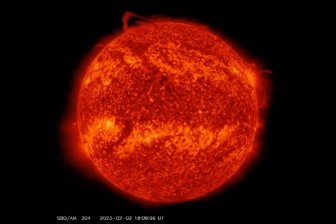Why didn’t Canada shoot down a Chinese spy balloon? Defence minister explains – National | Globalnews.ca
Ottawa was “examining the trajectory and analyzing” a Chinese spy balloon last week before it decided not to shoot it down, the national defence minister says.
Anita Anand explained to reporters in Washington on Friday that the Canadian government was closely monitoring the balloon with the United States via NORAD, the continental defence alliance between both countries, throughout its entire flight before the U.S. shot it down last weekend.
But why didn’t Canada decide to shoot it down when it was in Canadian airspace?
Read more:
U.S. shoots down ‘high-altitude’ object over Alaska
Read next:
Part of the Sun breaks free and forms a strange vortex, baffling scientists
“We were examining the trajectory and analyzing the balloon, including the height of the balloon and the contents of the balloon, and determined that it posed no imminent risk to Canadians at all,” Anand said. She met with U.S. Defense Secretary Lloyd Austin at the Pentagon as she wrapped up a two-day visit to Washington with Innovation Minister Francois-Philippe Champagne.
“We were watching it very carefully to ensure we were doing what is necessary to protect Canadians, and we’re doing that in the context of the NORAD relationship, of course, so that when the United States made that decision to shoot it down, Secretary Austin did thank Canada because we were making these decisions jointly about imminent threats.”
Read more:
Chinese spy balloon that was over U.S., Canada part of ‘broader’ operation: U.S. official
Read next:
Exclusive: Widow’s 911 call before James Smith Cree Nation murders reveals prior violence
The balloon was shot down by a U.S. military fighter jet on Saturday over the sea near South Carolina.
NORAD began tracking the balloon as it approached U.S. airspace, the Pentagon said Wednesday. It passed north of Alaska’s Aleutian Islands on Jan. 28 and moved largely over land across Alaska and then into Canadian airspace before crossing back into the U.S. over northern Idaho on Jan. 31.
Anand did not say Friday where the balloon was when it first entered Canadian airspace, or what locations it passed over and for how long it was over Canada before heading south.
The U.S. navy and coast guard are working to recover pieces of the downed balloon for analysis and they’re working to determine if it collected any intelligence from either country, Anand said.

“The analysis of the balloon and contents is what the United States is undertaking on its own. We’re not part of that,” she said.
“What we were making sure is that there was no threat to Canadians and the analysis about any further intelligence gathering is ongoing right now.”
The public announcement of the balloon’s discovery late last week sparked outrage in both countries and prompted U.S. Secretary of State Antony Blinken to cancel a trip to China that weekend.
In this photo provided by Chad Fish, the remnants of a large balloon drift above the Atlantic Ocean, just off the coast of South Carolina, with a fighter jet and its contrail seen below it on Feb. 4. China said Feb. 7 it will “resolutely safeguard its legitimate rights and interests” over the shooting down of a suspected Chinese spy balloon by the United States, as relations between the two countries deteriorate further.
Chad Fish via AP, File
That balloon was part of a “broader suite of operations” that are underway by Beijing, a U.S. official said Thursday. Jedidiah Royal, the U.S. assistant defence secretary for the Indo-Pacific, told a U.S. Senate Appropriations subcommittee Thursday the military has “some very good guesses” about what intelligence China was seeking.
When pressed on what information the balloon was specifically trying to gather, Royal said U.S. officials “are learning more as we exploit the contents of the balloon and the payload itself.”
“We understand that this is part of a broader suite of operations that China is undertaking to try to get a better understanding of the U.S.,” Royal said.

His public comments came just hours after The Associated Press (AP) reported that China’s balloon was equipped to collect intelligence signals and was part of a huge, military-linked aerial spy program that targeted more than 40 countries.
Citing a State Department official who provided details to reporters by email on condition of anonymity due to the sensitive nature of the matter, AP said a fleet of balloons operates under the direction of China’s People’s Liberation Army and is used specifically for spying, outfitted with high-tech equipment designed to collect sensitive information from targets across the globe.
Similar balloons have floated over five continents, according to the administration. China admitted on Monday that a balloon travelling over Latin America was also theirs.
Read more:
Canadian pilots were warned of ‘untethered balloon’ amid China surveillance concerns
Read next:
Google AI chatbot Bard gives wrong answer, sending shares plummeting
The details from the official were billed as an attempt to refute China’s denials that the balloon was used for spying, including a claim Thursday that U.S. accusations about the balloon amount to “information warfare” against Beijing.
The balloon was spotted over Montana on Feb. 2, which is home to one of America’s three nuclear missile silo fields at Malmstrom Air Force Base, according to a U.S. official who spoke on condition of anonymity to discuss sensitive information at the time.
The incident, as well as the American reports, prompted Ottawa to summon China’s ambassador to Canada.
Canadian relations with China have been uneasy for several years, intensifying in recent months over allegations of attempts to influence and interfere in Canadian affairs.
© 2023 Global News, a division of Corus Entertainment Inc.
For all the latest World News Click Here
For the latest news and updates, follow us on Google News.




